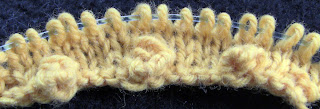There are many ways to knit a triangle shawl. This time, we are going to cover going from the bottom up using yarn overs to make the increases. I also show doing a KFB (knit front and back) increase if you want a less obvious increase.
This is just the bare bones of triangle shawls. I am sure you have seen many beautiful shawls that are lacy, some that are cabled, and many others.
The shawls pictured here were knit years ago. I am not certain what yarn was used. I think the one on the right is Caron Simply Soft, but it could very well be something else.
Below are a few examples of how to do a simple triangle shawl. Nothing fancy here. A shawl is a great beginner project if you want something larger than a scarf, but still want to keep it simple. You don't have to worry about gauge either.
These shawls are also a great project for seasoned knitters, because you can sit and watch TV and just mindlessly knit.
You can use any yarn and needles you like - the needles should be circulars though, to accomodate all of the stitches as the shawl grows. I'd say you want a 32 inch minimum. Of course if you are using a thin, lace weight yarn you could probably get away with a 24 inch circular; if you are using a thicker, bulkier yarn you may need to use a longer needle.
A good place to start is go to the craft store or your LYS, find a yarn you like, and just swatch using the needle size recommended on the ball band. If you find that you want a looser fabric, try a larger needle; if you want a denser fabric, go down a needle size. There is no wrong way to do this, so don't be worried that you may be using the wrong needle for your yarn. If you are pleased with your swatch, then you are using the right yarn and needles.
My shawls pictured above are just garter stitch, as are the samples in the video. You can do garter stitch if you like, or stockinette - maybe even alternate a few rows of garter with a few rows of stockinette.
Below are only a few ways you can do a bottom up triangle shawl. If you don't like any of these looks, play around and see what you can come up with. I used a US size 10.5 Knitter's Pride Cubics needle in my samples, and the first three were done in Mulberry Merino yarn, and the last in Paton's Classic Wool.
The first sample is a mini shawl from cast on to bind off. Yours of course will be much bigger.
Cast on 3 stitches
Knit across, turn
K1, YO, knit to end
Repeat the K1, YO, knit to end until the shawl is as big as you want it to be. Bind off, weave in loose ends and block if you like.
The second sample is done by making the yarn over at the beginning of each row. This makes a very decorative edge along your shawl.
Cast on 3
Knit across, turn
YO, knit to end
Repeat from YO, knit to end until shawl is desired size
Our third sample also uses a yarn over increase, and will create a wider border than either of the two above. This also gives a less pointy tip to the shawl.
Cast on 5
Knit across, turn
Knit 3, YO, knit to end
Repeat from Knit 3, YO, knit to end until shawl is desired size
Maybe you don't like the look of yarn overs. You can do any increase you like and are comfortable with. In my sample below, I used the KFB increase - knit front and back of the stitch.
Cast on 3
Knit across, turn
K1, KFB, knit to end
Repeat from K1, KFB, knit to end until shawl is desired size
Here is a video showing how I did all of the samples. I hope this helps those of you thinking about making a triangle shawl, but aren't quite sure where to start.








